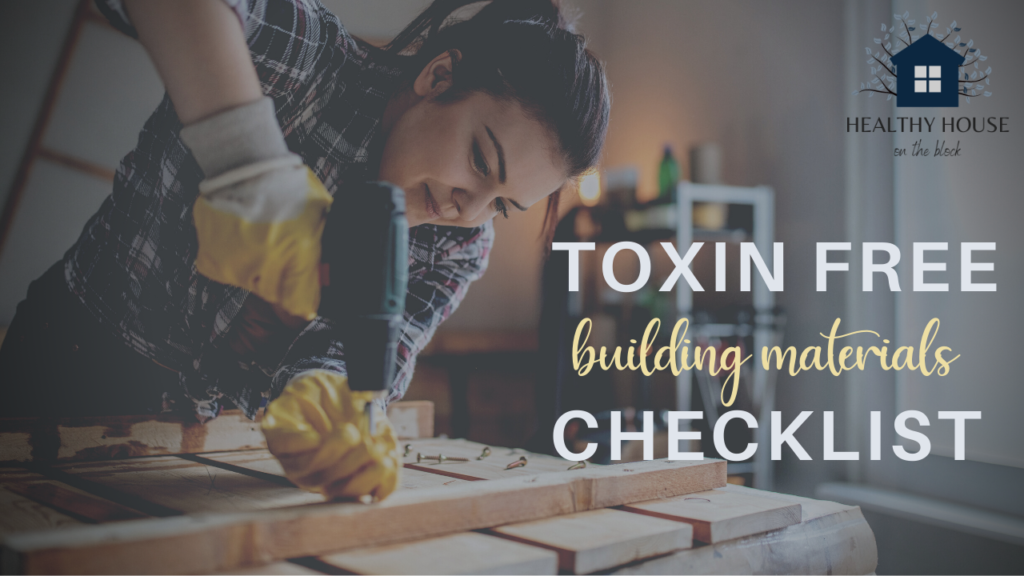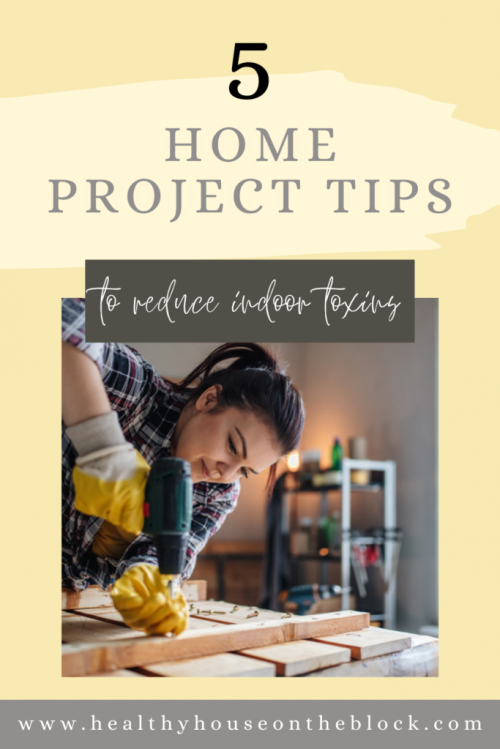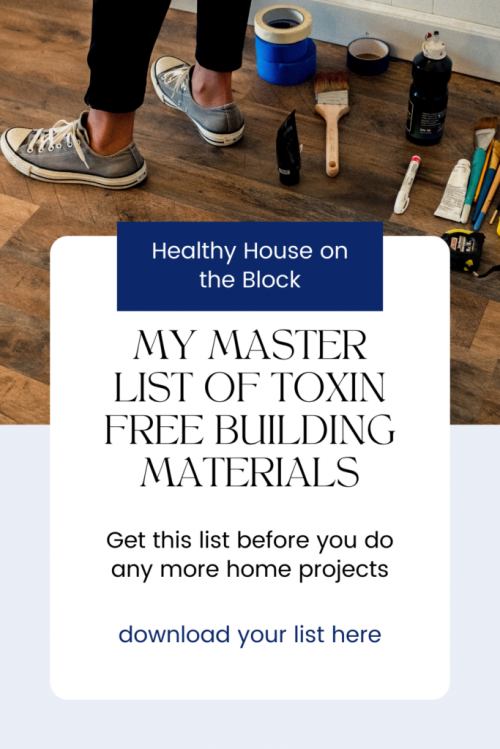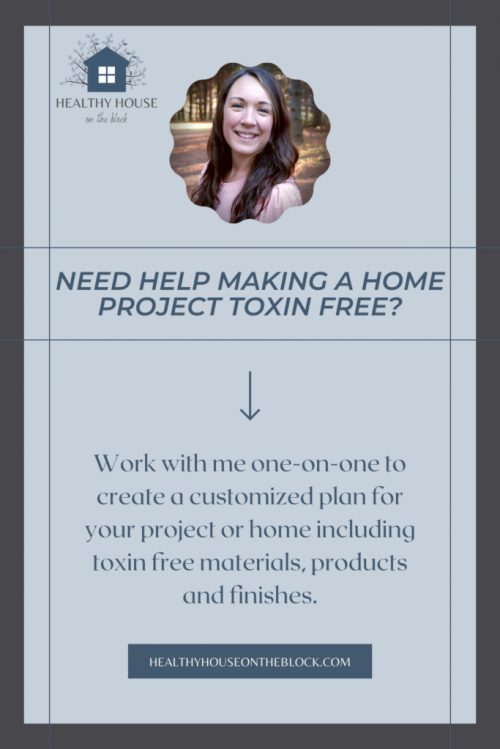
I don’t know that I’ve necessarily shared this before, but way back when my husband and I bought my childhood home from my parents, I started a blog about changing the home into ours. We took out wallpaper, installed new floors and worked to make it our own. Thirteen years ago I had no idea that toxin free building materials were even a thing, and I just used whatever was inexpensive or recommended.
Of course now that the health of my home is so important to me and to the health and wellness of my family, I know MUCH more about improving a space to make it healthier as well as make it feel like your own too.
Download My HUGE Toxin Free Building Materials Checklist
Perfect for any home project from remodels to small projects like furniture or adding elements like shiplap to your home.
USE COUPON CODE FIRST50 TO GET YOUR DOWNLOAD FOR FREE
Part of my work includes not only learning about new products and toxin free options for homes on a regular basis, but I also have to figure out the best way to get this information out to you and other homeowners that might want to make a healthier choice.
The download featured in this week’s blog post is an EXCELLENT tool for any home project and you can print it out next time you head to the hardware store. Choosing some of the options I have listed might just take a little bit more planning on your part, but I’m here to assure you there are SO many green and toxin free products readily available as home materials, you’ll probably find more options than you think.
TOXINS IN BUILDING MATERIALS
Building materials for a home don’t often get the chance to be changed, unless of course you’re building brand new. And most building materials that are inside our home have been installed or placed there without much regard for toxins. Many times the materials put into our homes are used based on the cost and not even based on the quality of the product.
This is why when you do a home project, it’s the perfect opportunity to change that part of your home and improve the quality of the materials and reduce the toxin level in the materials. Below are some of the biggest toxins that you can reduce in building materials:
- Formaldehyde (known carcinogen)
- Polyvinyl Acetate (hormone disruptor, neurological toxicity)
- PFOAs & PFCs (carcinogen, neurological damage)
- Xyelene (harmful to endocrine system and creates imbalance of free radicals in body)
- Toluene (damage to liver and kidneys)
- Styrene (carcinogen, liver and kidney damage, nervous system damage)
- Flame Retardants (endocrine system disruption, carcinogen, reduced fertility, hyperactivity, reduced IQ)
- Ethylene Glycol (decreased kidney function, long term lung issues and respiratory issues)
- Isocyanates (carginocneic)
PROJECT TIP: CONTAINING DUST

One of the best ways to make sure that your project doesn’t wreak havoc on your healthy home space is by not only using low toxin building materials, but also by containing any sort of dust produced during the project.
Dust can travel all throughout the house and land on just about any surface. It will continue to travel throughout your home and air, being breathed into lungs and irritating airways until it all eventually gets filtered out through your furnace or A/C filter.
Instead, try these tips to contain the dust to your work area:
Dustless Installation Method: This method of installation is quite common, and it’s essentially when the materials are all cut outside the home and then brought into the space after being wiped off to prevent any dust from getting into the home.
Block Vents/Grates: Any venting grates that are present in the room you’ll be working on can be blocked temporarily (you can tape them off with construction paper or you can use a magnetic sheet specifically made for this purpose. This will ensure that dust doesn’t travel into your duct system and clog up your furnace filter. It will also prevent the dust from traveling to other spaces.
Section Off Area: Using some sort of sheeting, either fabric or plastic to block the doorways and entrances to your work space can help prevent the fine dust from traveling throughout your home. All it takes is someone walking by to get the dust moving up into the air, and with a barrier, you’ll ensure it stays in the construction space.
Vacuum Project Space Daily: A good wet/dry vac is perfect for this type of situation. Try to vacuum your space once a day to keep dust and debris from getting tracked to other areas in your home. It might sound like a big job, but honestly, it helps so much in terms of keeping the rest of your home clean and dust free.
Change Filters After Project: And when you’re all done with your project, make sure you change filters in your vacuum, furnace, A/C and/or air purifier. The filters can not only become clogged, but the dust can re enter the home when filters are removed or canisters are emptied, etc.
PROJECT TIP: PROPER VENTILATION
Another good idea when you’re doing a home project is to keep your space well ventilated. Especially if you’re using projects that need to dry or cure, you’ll want plenty of fresh air to dilute the potential VOCs as the product dries. This might mean keeping a window open, or using a fan.
You can also keep a ventilator mask handy and use it when you’re cutting materials that may create fine dust or when you’re painting/staining surfaces. It’s a great way to protect your airways from foreign objects and materials.

CONSULTATIONS ON PROJECTS
One of the ways I love helping families who are looking to do a home project, major remodel or even building new is to consult with them and create a custom building materials list for their project.
Not only is it such a fun process to be a part of, but working with families at this particular stage offers SUCH a great way to reduce toxic materials from their home and improve their space to be supportive to their health and wellness. But sometimes it can get overwhelming trying to figure out all the materials you may need and then to find them in low toxin form.
This is where I can help reduce that burden on you and create a custom list with links you can use yourself or pass along to a contractor or designer for your project. It will give you options as to different types of products and materials you can either custom order or pick up at a hardware store depending on what your needs are.
If you get into the thick of a project and you can’t get a handle on products and materials, feel free to send me an email or view my consultations page to get an idea of exactly how I could help.
LOW TOXIN BUILDING MATERIALS CHECKLIST
The download below is a MUST for home projects. It will not only help you plan ahead, but also give you ideas of products that you can use in your home that are low toxin and toxin free.
I’m offering this download for free to the first twenty downloads and after that it will be just $5 to download in my online store. JUST ENTER CODE FIRST20 AT CHECKOUT.








